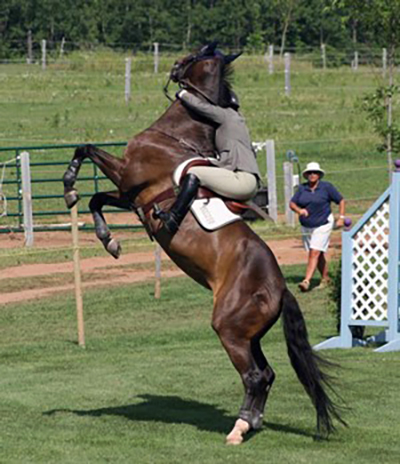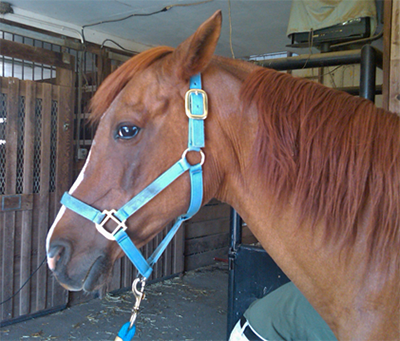Carissa Wickens, UF/IFAS Equine Specialist
—
Paying Attention to Horse Behavior
Learning how to recognize changes in behavior, and how to address behavioral problems appropriately is extremely important to ensuring your horse’s health and well-being, and to maintaining a positive horse-human relationship. It is often easy to place blame on the horse for problem behaviors, as we may attribute negative changes in behavior to the horse being disobedient. Horses, like people can experience a “bad day” every now and again, but when behavior changes persist or become more severe, an underlying physical or psychological problem is frequently the cause of the undesirable behavior. Regular observation of your horse is key to identifying the origin of the problem. Doing so will allow for effective treatment and/or adjustments in management that can result in improvements in the horse’s behavior.
By observing horses regularly:
- You learn what is “normal” behavior for a particular horse
- You pay attention to horse body language and are more likely to notice changes in behavior
- You can better detect and more quickly address physical problems and/or management issues
Changes in Behavior and Potential Causes

Excessive reactivity and severe anxiousness in horses may indicate an underlying physical problem. Photo credit: University of Minnesota Extension.
Changes in behavior can include the following:
- Negative attitude towards work
- Decline in performance
- Hyper-reactivity, spookiness, bolting
- Undesirable behaviors such as:
- Kicking
- Biting
- Teeth-grinding
- Head tossing
- Self-mutilation
Some potential causes of attitude changes and reluctance to work include:
- Gastric ulcers/abdominal discomfort
- Soreness in the horse’s back or limbs (Need to evaluate and determine the source of pain, e.g. some problem behaviors can be attributed to ill-fitting tack)
- Conflict behaviors in response to inconsistent training methods/cues
- Difficulty with thermoregulation (normal temperature)
Excessive reactivity and anxious behaviors may be the result of the following:
- High carbohydrate diet (feeds high in sugar/starches)
- Vision problems
- Pain or fear (facial expressions and body postures can indicate discomfort and arousal)
- Inadequate training/preparation for transport, competition, etc.
- Separation from other horses
- Temperament characteristics

This horse’s facial expressions are those exhibited in response to pain. Notice the tightened lips, strained nostril, prominent chin, tension above the eye, and stiff backward ear position. Photo credit: Carissa Wickens, UF/IFAS.
Undesirable behaviors can range from avoidance behaviors and head-tossing, to kicking and biting, or more severe, injurious behaviors such as flank-biting. In many cases of flank biting behavior (characterized as self biting) or when we observe horses becoming increasingly aggressive towards people and/or other horses, an underlying physical problem or abnormality is often a contributing factor. Avoidance behaviors such as shying away, rearing, and bucking/kicking out may result from pain or fear associated with unpleasant stimuli, but may also become learned behaviors as a result of inappropriate timing of reinforcements during training and handling. Keep in mind that changes in behavior such as lethargy, withdrawal from pasture mates and/or people, abnormal body, head and neck postures may also indicate a problem.
Working on Solutions
Figuring out the source of your horse’s behavior change and addressing equine behavioral issues can be challenging. Knowing what is “normal” behavior for your horse (e.g. eating, drinking, urinating, defecating, body postures and facial expressions, behavior towards other horses, people, etc.) will help you recognize when your horse is uncomfortable or stressed. This information is essential in order to determine the reason for the change in behavior or behavior problem. Moreover, the behavior could have more than one cause (i.e. the behavior may be the result of a combination of factors).
It is helpful to consider the context of the behavior, i.e. making note of when and where the behavior occurs. What else is happening in the horse’s environment when the horse displays the behavior? It is often a good idea to record some video of the horse’s behavior, so that you have a visual account of what is happening. Collecting video of the horse alone in his/her stall or paddock or during times of the day when there is less activity around the farm can also reveal important information. Video is especially helpful as you work closely with your veterinarian to rule out pain/physical conditions.
When tackling behavioral problems, be patient and willing to make changes, however avoid making too many changes at once, so that you can observe which treatment or adjustment in management or training has been effective. Always consider your own safety, the safety of the horse, and of those around you, and recognize when you need to seek outside help.
References and Further Reading
- McDonnell, S. 1999. Understanding Horse Behavior. The Blood-Horse (Horse Health Care Library).
- Mills, D. and Nankervis, K. (1999) Equine Behavior: Principles and Practice. Blackwell Science, Oxford.
- Managing the Anxious Horse
